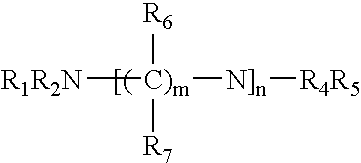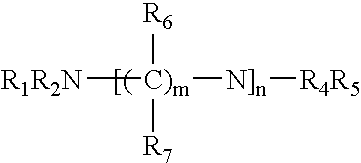Non-Aqueous Photoresist Stripper That Inhibits Galvanic Corrosion
a non-aqueous, galvanic corrosion technology, applied in the direction of photomechanical equipment, detergent compounding agents, instruments, etc., can solve the problems of metal circuitry, significant corrosion, and metal is also severely attacked
- Summary
- Abstract
- Description
- Claims
- Application Information
AI Technical Summary
Benefits of technology
Problems solved by technology
Method used
Image
Examples
Embodiment Construction
[0015]Back end photoresist strippers and cleaning compositions of this invention are provided by non-aqueous, non-corrosive cleaning compositions that resist galvanic corrosion when used on stacked layer structures of different types of metals at a surface of an electronic device. Such non-aqueous photoresist strippers and cleaning compositions comprise:[0016](a) at least one polar organic solvent,[0017](b) at least one di or polyamine having both at least one primary amine group and one or more secondary and / or tertiary amine groups, and having the formula
[0018]wherein R1, R2, R4, and R6 can each independently be H, OH, hydroxyalkyl and aminoalkyl groups; R6 and R7 are each independently H or alkyl groups, and m and n are each independently integers of 1 or larger, with the proviso that R1, R2, R4, and R5 are selected so that there is at least one primary amine group and at least one secondary or tertiary amine group in the compound, and[0019](c) at least one corrosion inhibitor th...
PUM
| Property | Measurement | Unit |
|---|---|---|
| weight | aaaaa | aaaaa |
| corrosion | aaaaa | aaaaa |
| compatibility | aaaaa | aaaaa |
Abstract
Description
Claims
Application Information
 Login to View More
Login to View More - R&D
- Intellectual Property
- Life Sciences
- Materials
- Tech Scout
- Unparalleled Data Quality
- Higher Quality Content
- 60% Fewer Hallucinations
Browse by: Latest US Patents, China's latest patents, Technical Efficacy Thesaurus, Application Domain, Technology Topic, Popular Technical Reports.
© 2025 PatSnap. All rights reserved.Legal|Privacy policy|Modern Slavery Act Transparency Statement|Sitemap|About US| Contact US: help@patsnap.com



